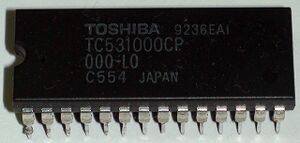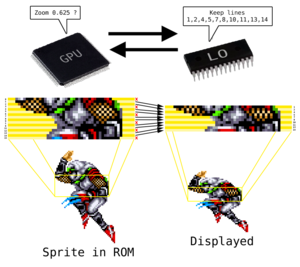L0 ROM: Difference between revisions
No edit summary |
mNo edit summary |
||
| Line 1: | Line 1: | ||
[[File:aes_lo.jpg|right|thumb|Toshiba LO ROM chip taken from an AES system.]] | [[File:aes_lo.jpg|right|thumb|Toshiba LO ROM chip taken from an AES system.]] | ||
[[File:cd2_lo.jpg|right|thumb|LO ROM chip found on a CDM3-2 board.]] | [[File:cd2_lo.jpg|right|thumb|LO ROM chip found on a CDM3-2 board.]] | ||
[[File:Ngscaling.png|right|thumb]] | |||
LO stands for "LOokup". It's a 64KiB ROM chip found in every NeoGeo systems, which contains byte values used by the [[GPU]] to shrink [[sprites]] vertically. | LO stands for "LOokup". It's a 64KiB ROM chip found in every NeoGeo systems, which contains byte values used by the [[GPU]] to shrink [[sprites]] vertically. | ||
Revision as of 16:55, 29 November 2012


LO stands for "LOokup". It's a 64KiB ROM chip found in every NeoGeo systems, which contains byte values used by the GPU to shrink sprites vertically.
The dump is often called 000-lo.lo in BIOS sets.
Data
The data contained in this ROM is actually 256 tables of 256 bytes, each table corresponding to a value of the vertical shrinking for sprites.
For the first 256 lines (first half of a full sprite), the index in the table is the horizontal line number of the sprite currently being drawn (scanline - Y position).
Each byte is used as 2 nibbles:
- The upper nibble is the tile number index to read in the tilemap table in VRAM SCB1 (0 to 15).
- The lower nibble is the line number of that tile to fetch in the C ROMs.
For the last 256 lines (second half of a full sprite), the index in the table is 255-((scanline - Y position) & 255). The table is read backwards.
Each byte is used as 2 nibbles:
- The upper nibble is the tile number index XOR $1F to read in the tilemap table in VRAM SCB1 (0 to 15).
- The lower nibble is the line number XOR $F of that tile to fetch in the C ROMs.
Example of GPU processing
(Maybe place this part in the GPU page ?)
Sprite with Y zoom value = $1B and tile height = 2 (32 pixels).
- Line 0 of sprite. GPU asks LO data at address $1B00. Data is $00: Tilemap index 0, line 0 of tile.
- Line 1 of sprite. GPU asks LO data at address $1B01. Data is $08: Tilemap index 0, line 8 of tile.
- Line 2 of sprite. GPU asks LO data at address $1B02. Data is $10: Tilemap index 1, line 0 of tile.
...
- Line 26 of sprite. GPU asks LO data at address $1B1A. Data is $E8: Tilemap index is $E, line 8 of tile.
- Line 27 of sprite. GPU asks LO data at address $1B1B. Data is $F8: Tilemap index is $F, line 8 of tile.
- Line 28 of sprite. GPU asks LO data at address $1B1C. Data is $FF: Tilemap index is $F, line $F of tile.
- Line 29 of sprite. GPU asks LO data at address $1B1D. Data is $FF: Tilemap index is $F, line $F of tile.
...
Datasheet
Official TC531001 datasheet: [[1]]